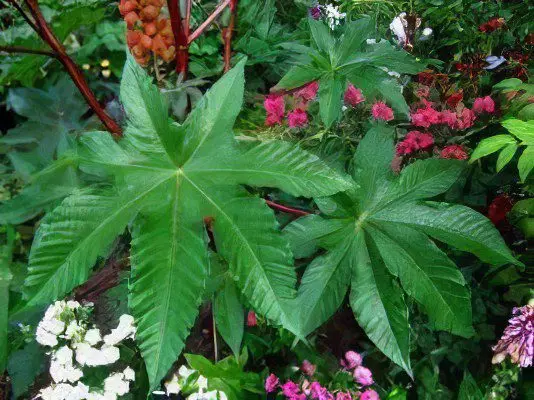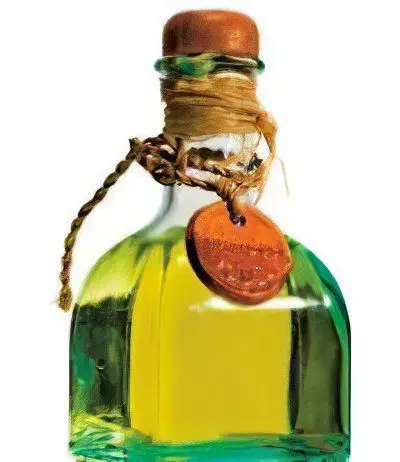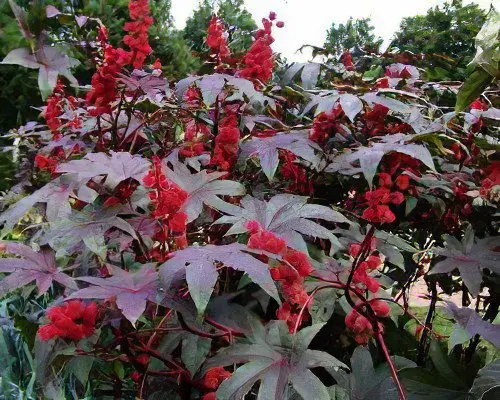Contents
Useful properties and use of castor oil
Useful properties of castor beans

Castor seeds contain 45-60% non-drying fatty oil, which includes unsaturated ricinoleic acid glyceride (castor oil), lipase enzyme, stearic, oleic, linoleic acids and glycerin. Even in the seeds of the plant, protein substances were found, such as globulin and albumin, a small amount of alkaloids, a small amount of nitrogen-free substances and fiber.
The composition of the herb also contains such a toxic protein substance as ricin. During cold pressing of seeds to obtain oil from them (with subsequent treatment with steam and hot water), a certain amount of poison is destroyed, most of it remains in the waste – cake. Ricin is a protoplasmic poison, it inhibits protein biosynthesis at the level of ribosomes. It is found in all parts of the plant and is a byproduct of the production of castor oil.
In addition, the seeds of the plant contain a large number of micro and macro elements: potassium, calcium, magnesium, iron and others. For medicinal purposes, the leaves and seeds of the plant are used, producing castor oil from them. It is a laxative, wound healing and anti-inflammatory agent.
Application of castor oil
Castor oil is widely used in medicine. It is prescribed for inflammation of the gastrointestinal tract, colitis and feverish conditions. Externally, the oil is used to treat ulcers, burns, and also as an aid in the removal of warts. In cosmetology, it is used to whiten age spots and rapid growth of eyelashes. In gynecology, oil is used to stimulate the contractile activity of the uterus. In addition, inflammatory diseases of the uterus are treated with an infusion of herbs, and for colds and bronchitis they rub the chest.
Leaf infusion: 10 g of crushed leaves should be poured into a glass of boiling water and insisted for 15 minutes in a boiling water bath, after which the mixture should be cooled and filtered. It is recommended to take the infusion three times a day, one tablespoon for endometritis.
Castor oil is poisonous
The seeds of this plant can cause serious damage to health, as it is considered the most poisonous of all seed species. The toxins present in the herb inhibit the synthesis of proteins in the intestinal wall, causing it to collapse and the intestines to stop functioning. However, castor oil is obtained from the plant and is considered safe. The seeds of the plant can easily be poisoned.
The first signs of castor bean poisoning may appear only after a few hours. It is symptomatic of yellowing of the skin, burning and pain in the abdomen, nausea and vomiting, severe headache, weakness, convulsions, acceleration or slowing of the pulse, and possible respiratory arrest.
At the first signs of poisoning, you should immediately call a doctor and provide first aid to the patient. It consists in washing the stomach and a warm heating pad on the person’s stomach.
Castor bean oil

The plant contains up to 60% non-drying fatty oil. It has special technical qualities, due to which it is widely used in various industries. In medicine, this oil is called castor oil. Castor oil has a high viscosity and density, as well as high reactivity. It contains approximately 90% ricinoleic acid, 1% palmitic, 1% stearic, 3% oleic and 4% linoleic.
Castor oil does not dissolve in water, but it dissolves well in alcohol. It has a mild odor and a characteristic unpleasant taste. In air, it thickens, but does not oxidize; at temperatures below minus 15 ° C, it can solidify to a jelly state.
castor seeds
Seeds ripen in the fruits of the plant. They are ovoid or round in shape and have a smooth, shiny skin. They contain the poisonous substance ricin, which causes severe poisoning. An antidote has not yet been created for this poison, it is many times more toxic than potassium cyanide, sarin gas and cobra venom.
Castor oil is extracted from the seeds by cold pressing followed by heat treatment. The plant and its properties were known in ancient times, since grass seeds were discovered during excavations of ancient Egyptian sarcophagi.
castor beans
The fruit of the plant is a spherical three-leaved box. Each valve contains one seed. In some plant species, the fruits are covered with thorns. Castor bean fruits are harvested 3-4 times per season as they ripen. From the fruit, castor oil is obtained, which contains a large amount of glycerides of ricinoleic acid. Everything in this herb is poisonous: leaves, flowers, fruits. Wash hands immediately and thoroughly after contact with fruits.
Cultivation of castor beans

Growing castor beans is not that difficult, although it should be noted that the plant does not tolerate frost and loves sunny places. The soil for it should be loose, nutritious, with good moisture and deeply cultivated. Seeds are sown in the first decade of April. The best option for sowing seeds is by the piece. Sow in separate peat or plastic cups to a depth of 1–2 cm. Under good conditions, seedlings may appear as early as the third day after sowing.
During germination, the cotyledon leaves of the plant are covered with an oily sticky peel, which must be removed to prevent rotting of the sprouts. In order not to damage the delicate leaves, the peel is moistened and carefully removed.
Castor bean care. To accelerate the germination of hard-to-growth large seeds, scarification is usually used (cutting the hard seed coat). In addition, the plant needs to be watered abundantly and be sure to weed it regularly, because at the initial stage of development, the castor plant grows slowly and weeds can drown it out. It is also desirable to feed it with mineral fertilizers containing nitrogen. It is better to process the plant with gloves and after finishing work, be sure to wash your hands.
Castor bean
The name of the plant comes from the Latin word ricinuc – tick, which is associated with the shape of the seeds, reminiscent of an oriental tick. The herb is native to tropical Africa. There the plant has a tree-like form and reaches a height of 10 meters. In temperate climatic zones, it is an annual plant up to 2 m high, with a branched stem. Large palmate leaves grow on long petioles. Racemes are located at the ends of the shoots or in the axils of the leaves.
The plant is widely cultivated for medicinal and technical purposes. It is widely cultivated on all continents. Castor oil grows in the North Caucasus, in Asia Minor and Central Asia, in Transcaucasia, in the steppe regions of Ukraine and in the Lower Volga region.
Contraindications to the use of castor oil
The plant is deadly poisonous! In no case should you try castor bean seeds. If you accidentally ate them, then you must definitely induce vomiting and rinse your stomach.
Abuse of castor oil may cause indigestion. Before using herbal medicines, you should consult your doctor. The use of oil by pregnant and lactating women is undesirable.









